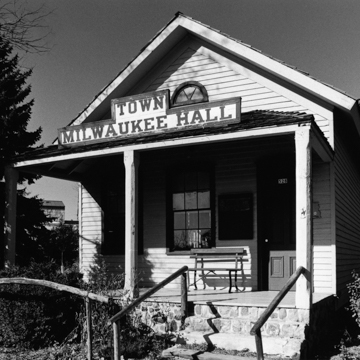Even in its suburban setting, this simple building reminds us of Milwaukee County’s rural roots. In 1872 the Town of Milwaukee’s residents, tired of meeting in taverns and private homes, voted to spend $1,000 to build this hall. Contractor Severin erected the clapboarded one-story hall on a stone foundation. The front-facing gable features a lunette window, and chamfered posts support the full-width, hipped porch roof. Inside, the hall has board-and-batten walls, a flush-boarded ceiling, and a planked floor. The original furnishings evoke an era when townspeople sat through town meetings on long wooden benches, the three supervisors used armchairs, and a pot-bellied stove provided warmth. Today this room is a museum and a once-a-year meeting place for the Glendale City Council.
Established in 1838, the Town of Milwaukee filled the northern half of Milwaukee County, an agricultural area settled by German, Swiss, Dutch, and French farmers. In the 1840s the township lost much of its territory to Wauwatosa and Granville townships and the newly incorporated City of Milwaukee. A century later, as the City of Milwaukee’s annexations incorporated adjacent town lands, Milwaukee’s suburbs also annexed and developed the town’s former farmland through municipal incorporations. Finally, in 1950, Glendale incorporated as a city, and the Town of Milwaukee dissolved. To save this rare example of a rural town hall from demolition, the City of Glendale moved it behind the modern municipal building in 1963 from its original site near the intersection of Bender and Port Washington roads, where it once stood amid pastures and farms.


